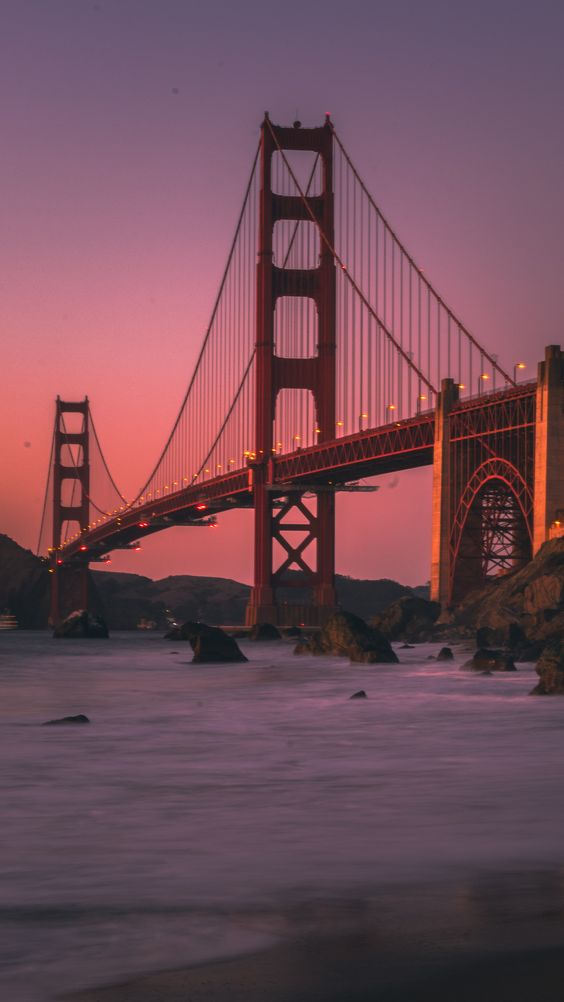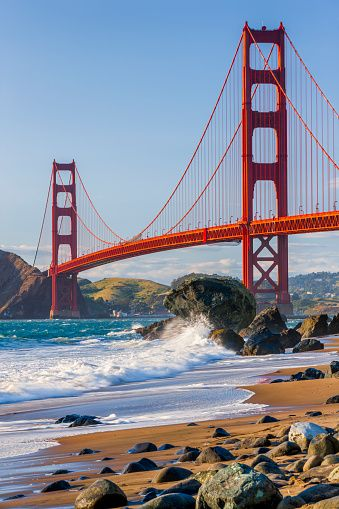All over the world, there are several marvels of civil engineering. One of them is the Golden Gate Bridge. It symbolises the skill and might of civil engineers. This article will cover every aspect of the bridge.
Let’s begin with the fundamentals.

Source: Pinterest
See also: Biggest house in the world: Istana Nurul Iman
Golden Gate Bridge: Overview
The one-mile-wide (1.6 km) strait known as the Golden Gate is crossed by the suspension bridge known as the Golden Gate Bridge, which connects San Francisco Bay and the Pacific Ocean.
The bridge links Marin County with the northernmost point of the San Francisco Peninsula, bringing together two American cities. Route 101 and California State Route 1 both cross the strait.
The bridge is one of the most well-known landmarks in both California and San Francisco. Its original design was created in 1917 by architect Joseph Strauss. The American Society of Civil Engineers has recognised it as one of the wonders of the modern world.

Source: Pinterest
Golden Gate Bridge: Architecture
Strauss was the principal engineer in charge of the entire planning and execution of the bridge project. However, other experts were in charge of much of the engineering and design because he lacked understanding or experience in cable suspension structures.
Strauss’s first design suggestion, which consisted of two double cantilever spans joined by a central suspension element, was improper from an aesthetic standpoint. Engineer Leon Moisseiff of New York City created and promoted the last, most exquisite suspension design.
Irving Morrow, a mostly unheard-of residential architect, created the general layout of the bridge towers, the lighting setup, and the Art Deco accents like the tower decorations, lamps, railings, and pathways. Morrow chose the recognisable Foreign Orange colour over other possibilities, including the US Navy’s request that it be painted with black and yellow stripes to increase visibility to passing ships.
Senior engineer Charles Alton Ellis served as the project’s lead engineer while collaborating remotely with Moisseiff. The fundamental structural plan was created by Moisseiff, who used his “deflection theory,” according to which the wind would bend a thin, flexible highway, greatly decreasing stress by sending pressures to the bridge towers through suspension cables.
The original Tacoma Narrows Bridge, a later Moisseiff design, collapsed in a violent windstorm not long after it was built, but the Golden Gate Bridge’s design has shown to be reliable.
Ellis was also tasked with building a “bridge inside a bridge” in the southern abutment to prevent the need to destroy Fort Point, a pre-Civil War masonry fortress deemed worthy of historic preservation even at the time. He constructed a beautiful steel arch that spans the fort and carries the road to the bridge’s southern mooring. Ellis contributed significantly to the technological and theoretical effort that went into building the bridge, although he didn’t get any recognition for it during his lifetime.
In November 1931, Strauss fired Ellis and replaced him with Clifford Paine, a former employee, purportedly because he was spending too much money sending telegrams to Moisseiff. Due to his obsession with the project and inability to find other employment during the Great Depression, Ellis was able to put in 70 hours a week of unpaid effort, eventually producing 10 volumes of hand calculations.
With an eye toward self-promotion and the future, Strauss minimised the contributions of his collaborators, who, although receiving no credit or payment, were largely responsible for the bridge’s final design. He was able to establish himself as the main architect and visionary of the bridge. Only later did the other members of the design team receive full recognition for their services.
In May 2007, the Golden Gate Bridge District decided to give Ellis significant credit for the bridge’s design and published a formal report on its 70 years of management.

Source: Pinterest
Crossing the Golden Gate Bridge: Traffic
The bridge is not formally a member of the California Highway System, despite being a component of the National Highway System. The moveable middle barrier between the lanes is moved many times each day to accommodate traffic conditions.
On weekday mornings, there is a greater amount of southbound traffic entering the town; hence four of the six lanes are southbound.
On weekday afternoons, four lanes pass northward.
Over weekends and off-peak hours, there are three lanes in each direction of traffic.
How to reach Golden Gate Bridge
Golden Gate Bridge can be reached by the following modes of transportation:
- Rail: The nearest train station to Golden Gate Bridge is the Millbrae Station, which is served by Caltrain and BART. From there, one can take a bus or taxi to reach the Bridge.
- Road: The Golden Gate Bridge is accessible by car via US-101 N or S, which runs north and south along the Pacific coast. There are several parking lots and garages near the Bridge.
- Air: The nearest airport to Golden Gate Bridge is San Francisco International Airport (SFO). From there, one can take a taxi, bus, or shuttle to reach the Bridge. Another option is to take BART from SFO to the Millbrae Station, then transfer to a bus or taxi to reach the Bridge.
FAQs
How long is the Golden Gate Bridge?
The Golden Gate Bridge has a length of 1.7 miles (8,981 feet or 2,737 metres).
When was the Golden Gate Bridge built?
The Golden Gate Bridge’s construction began on January 5, 1933, and was completed on May 27, 1937.
How tall is the Golden Gate Bridge?
The main towers of the Golden Gate Bridge are 227 metres (746 feet) tall.
How much does it cost to walk or bike across the Golden Gate Bridge?
There is no charge for pedestrians or cyclists to cross the Golden Gate Bridge.
| Got any questions or point of view on our article? We would love to hear from you.
Write to our Editor-in-Chief Jhumur Ghosh at jhumur.ghosh1@housing.com |
Housing News Desk is the news desk of leading online real estate portal, Housing.com. Housing News Desk focuses on a variety of topics such as real estate laws, taxes, current news, property trends, home loans, rentals, décor, green homes, home improvement, etc. The main objective of the news desk, is to cover the real estate sector from the perspective of providing information that is useful to the end-user.
Facebook: https://www.facebook.com/housing.com/
Twitter: https://twitter.com/Housing
Email: editor@housing.com












